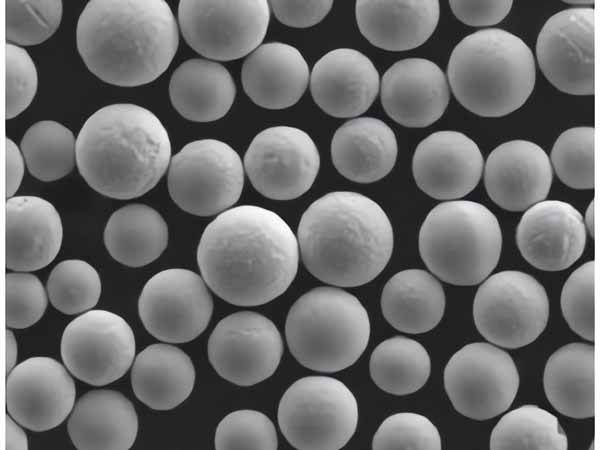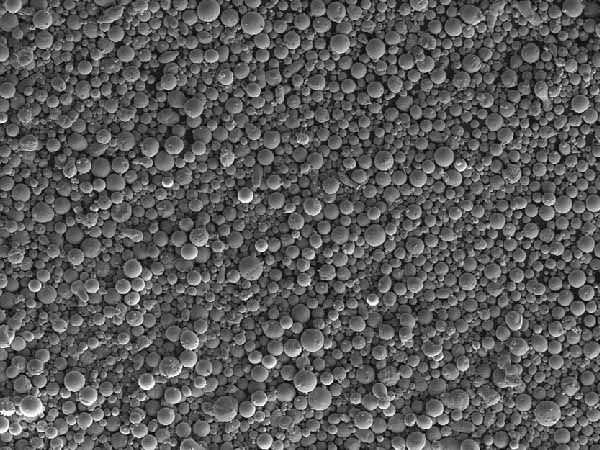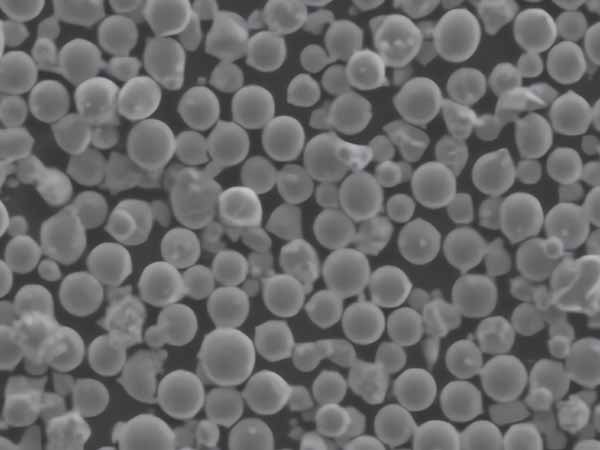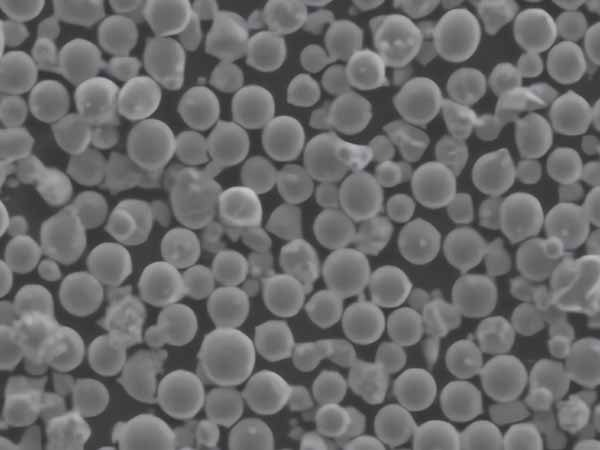개요
바인더 제팅 적층 제조 는 제조에 대한 사고방식을 혁신적으로 바꾸고 있습니다. 3D 프린팅 제품군의 일부인 이 혁신적인 기술은 액체 결합제를 사용하여 분말 재료의 층을 융합하여 고체 부품을 만듭니다. 바인더 제팅의 다재다능함은 금속, 세라믹, 폴리머 등 다양한 재료와 함께 사용할 수 있다는 데 있습니다. 비용 효율적이고 빠르며 프로토타입 제작과 대규모 생산 모두에 적합합니다. 바인더 제팅의 세계로 들어가 그 복잡성과 응용 분야, 그리고 이 혁신적인 공정에 사용되는 특정 금속 분말에 대해 자세히 알아보세요.
바인더 제팅 적층 제조의 종류와 구성
바인더 제팅 기술은 다양한 유형의 파우더와 바인더를 활용할 수 있습니다. 자세히 살펴보세요:
| 재료 유형 | 구성 | 속성 | 특성 |
|---|---|---|---|
| 금속 분말 | 철, 강철, 청동, 티타늄, 니켈 | 높은 강도, 내구성 | 기능성 부품, 높은 열 및 전기 전도성 우수 |
| 세라믹 파우더 | 알루미나, 지르코니아, 실리콘 카바이드 | 높은 경도, 내열성 | 고온 응용 분야, 내마모성 부품에 적합 |
| 폴리머 파우더 | 폴리아미드, 폴리프로필렌 | 가볍고 유연한 유연성 | 복잡한 형상에 이상적이며 금속에 비해 내구성이 떨어집니다. |

응용 프로그램 바인더 제팅 적층 제조
바인더 제팅의 다용도성 덕분에 다양한 애플리케이션에 적합합니다:
| 산업 | 애플리케이션 |
|---|---|
| 항공우주 | 경량 구조 구성 요소 |
| 자동차 | 엔진 부품, 프로토타입 |
| 의료 | 맞춤형 임플란트, 수술 도구 |
| 소비재 | 주얼리, 맞춤형 아이템 |
| 산업 제조 | 툴링, 금형 |
| 예술 및 디자인 | 조각품, 예술품 |
사양, 크기, 등급 및 표준
바인더 제팅을 위한 파우더와 바인더를 선택할 때는 사양, 크기, 등급 및 표준을 고려하는 것이 중요합니다:
| 재질 | 사양 | 크기 범위(미크론) | 등급 | 표준 |
|---|---|---|---|---|
| 스테인리스 스틸 | ASTM A240 | 10-100 | 316L | ISO/ASTM 52900 |
| 티타늄 | ASTM F2924 | 15-45 | Ti6Al4V | ISO 5832-3 |
| 알루미늄 | ASTM B209 | 20-60 | 6061 | AMS 4027 |
| 니켈 합금 | ASTM B444 | 20-50 | 인코넬 718 | AMS 5662 |
특정 금속 분말 모델
다음은 바인더 제팅에 일반적으로 사용되는 금속 분말 모델입니다:
- 316L 스테인리스 스틸
- 구성: 구성: 철, 크롬, 니켈, 몰리브덴
- 속성: 내식성, 우수한 강도
- 애플리케이션 의료 기기, 항공우주 부품
- 17-4 PH 스테인리스 스틸
- 구성: 구성: 철, 크롬, 니켈, 구리, 니오븀
- 속성: 고강도, 우수한 내식성
- 애플리케이션: 밸브, 기어, 수술 도구
- 인코넬 625
- 구성: 구성: 니켈, 크롬, 몰리브덴, 니오브
- 속성: 고온 강도, 내산화성
- 애플리케이션: 터빈 블레이드, 항공우주 부품
- 인코넬 718
- 구성: 구성: 니켈, 크롬, 철, 니오븀, 몰리브덴
- 속성: 높은 인장 강도, 우수한 크리프 저항성
- 애플리케이션: 제트 엔진 부품, 원자로
- Ti6Al4V(티타늄 합금)
- 구성: 구성: 티타늄, 알루미늄, 바나듐
- 속성: 높은 중량 대비 강도 비율, 내식성
- 애플리케이션: 항공우주 부품, 의료용 임플란트
- 구리
- 구성: 구성: 순수 구리
- 속성: 뛰어난 열 및 전기 전도성
- 애플리케이션: 전기 부품, 열교환기
- 알루미늄 6061
- 구성: 구성: 알루미늄, 마그네슘, 실리콘
- 속성: 우수한 기계적 특성, 내식성
- 애플리케이션 자동차 부품, 구조 부품
- 코발트-크롬
- 구성: 구성: 코발트, 크롬, 몰리브덴
- 속성: 높은 내마모성, 생체 적합성
- 적용 분야 치과 임플란트, 정형외과 임플란트
- 하스텔로이 X
- 구성: 구성: 니켈, 크롬, 철, 몰리브덴, 코발트
- 속성: 고온 강도, 내산화성
- 애플리케이션 가스터빈 부품, 석유화학 산업
- 브론즈
- 구성: 구성: 구리, 주석
- 속성: 낮은 마찰, 높은 내마모성
- 애플리케이션: 베어링, 부싱






공급업체 및 가격 세부 정보
바인더 제팅 기술을 효과적으로 구현하려면 시장과 공급업체를 이해하는 것이 중요합니다:
| 공급업체 | 재질 | 가격 범위($/kg) | 연락처 |
|---|---|---|---|
| GKN 분말 야금 | 스테인리스 스틸, 티타늄 | 50-150 | www.gknpm.com |
| 카펜터 기술 | 인코넬, 티타늄 | 100-300 | www.cartech.com |
| 샌드빅 오스프리 | 스테인리스 스틸, 알루미늄 | 40-120 | www.materials.sandvik |
| 프렉스에어 표면 기술 | 니켈 합금, 코발트-크롬 | 80-250 | www.praxairsurfacetechnologies.com |
| 회가나스 | 철, 청동 | 20-100 | www.hoganas.com |
바인더 제팅 적층 제조의 장단점
바인더 제팅의 장점과 한계를 평가하면 특정 애플리케이션에 대한 적합성을 결정하는 데 도움이 될 수 있습니다:
| 장점 | 단점 |
|---|---|
| 대규모 프로덕션에 비용 효율적 | 제한된 재료 옵션 |
| 빠른 제작 속도 | 낮은 기계적 특성 |
| 지원 구조가 필요 없음 | 후처리가 필요한 경우가 많습니다. |
| 복잡한 지오메트리 생성 기능 | 파우더 관리 과제 |
| 다양한 소재 옵션 | 높은 다공성 가능성 |
바인더 제팅 적층 제조의 특성
바인더 제팅은 다른 적층 제조 기술과 구별되는 고유한 특성을 제공합니다:
- 속도와 효율성
- SLS(선택적 레이저 소결) 또는 DMLS(직접 금속 레이저 소결)와 같은 다른 3D 프린팅 방식에 비해 바인더 젯팅은 훨씬 더 빠릅니다. 고속 열차와 일반 여객 열차를 비교하는 것과 비슷합니다. 고속 열차는 빠른 이동을 위해, 일반 여객 열차는 일상적인 편의를 위해 설계되었습니다.
- 비용 효율성
- 바인더 제팅은 레이저나 기타 고가의 장비가 필요하지 않으므로 초기 설정 비용과 지속적인 운영 비용이 저렴합니다. 집에서 요리하는 것과 외식을 하는 것의 차이로 생각하면 둘 다 식사를 제공하지만 한 쪽이 훨씬 더 예산 친화적입니다.
- 소재의 다양성
- 이 방법은 금속과 세라믹부터 폴리머에 이르기까지 다양한 재료에 사용할 수 있습니다. 마치 제조 분야의 스위스 아미 나이프와 같이 다양한 작업을 처리할 수 있는 다재다능한 제품입니다.
- 복잡한 지오메트리
- 바인더 제팅은 지지 재료 없이도 복잡한 디자인과 내부 구조를 제작할 수 있습니다. 병 안에 복잡한 모형 배를 만든다고 상상해 보세요. 바인더 제팅을 사용하면 병을 깨뜨리지 않고도 제작이 가능합니다.
- 환경 영향
- 이 공정은 재료 낭비가 적고 재활용 분말을 사용할 수 있기 때문에 기존 제조 방식에 비해 환경 친화적일 수 있습니다. 파이를 만들 때 사과의 모든 부분을 사용하는 것과 같아서 효율적이고 낭비가 없습니다.
장점 바인더 제팅 적층 제조
바인더 제팅은 기존 제조 방법 및 기타 적층 제조 기술에 비해 몇 가지 장점이 있습니다:
- 자유로운 디자인
- 지원 구조 없이도 복잡하고 정교한 디자인을 만들 수 있다는 점은 엔지니어와 디자이너에게 무한한 가능성을 열어줍니다. 마치 몇 가지 기본 색조 대신 아티스트의 전체 색상 팔레트를 사용하는 것과 같습니다.
- 확장성
- 바인더 제팅은 소규모 및 대규모 생산 모두에 적합합니다. 고유한 프로토타입을 제작하든 부품을 대량 생산하든, 바인더 제팅은 필요에 따라 확장할 수 있습니다. 한 끼 식사를 준비하거나 연회 음식을 제공할 수 있는 다재다능한 요리사라고 생각하면 됩니다.
- 비용 효율성
- 대량 생산의 경우 바인더 제팅은 다른 적층 제조 방법보다 비용 효율이 높습니다. 재료 낭비가 적고 생산 시간이 단축되어 비용을 절감할 수 있습니다. 마트에서 대량으로 구매하는 것과 비슷하게, 더 많이 만들수록 각 단가가 낮아집니다.
- 재료 범위
- 이 기술은 금속과 세라믹부터 폴리머까지 다양한 소재에 적용할 수 있습니다. 이러한 다용도성 덕분에 다양한 산업과 애플리케이션에 적합합니다. 마치 모든 작업에 사용할 수 있는 모든 도구가 들어 있는 툴킷을 가지고 있는 것과 같습니다.
- 신속한 프로토타이핑
- 바인더 제팅은 빠른 속도로 프로토타입을 빠르게 제작할 수 있어 반복 작업과 출시 기간을 단축할 수 있습니다. 아이디어를 스케치하고 몇 시간 안에 실현되는 것을 볼 수 있다고 상상해 보세요. 이것이 바로 바인더 제팅의 힘입니다.

자주 묻는 질문
| 질문 | 답변 |
|---|---|
| 바인더 제팅이란 무엇인가요? | 바인더 제팅은 액체 결합제를 사용하여 분말 재료의 층을 결합하여 고체 부품을 만드는 적층 제조 공정입니다. |
| 바인더 제팅에는 어떤 재료를 사용할 수 있나요? | 바인더 제팅에는 금속(스테인리스 스틸, 티타늄, 인코넬 등), 세라믹, 폴리머 등 다양한 소재를 사용할 수 있습니다. |
| 바인더 제팅은 다른 3D 프린팅 방법과 어떻게 다른가요? | 바인더 제팅은 일반적으로 SLS 및 DMLS와 같은 방법보다 빠르고 비용 효율적이지만 원하는 표면 마감과 강도를 얻기 위해 더 많은 후처리가 필요할 수 있습니다. |
| 바인더 제팅의 주요 용도는 무엇인가요? | 바인더 제팅은 항공우주, 자동차, 의료, 소비재, 산업 제조 등 다양한 산업에서 부품, 프로토타입, 복잡한 설계를 위해 사용됩니다. |
| 바인더 제팅 부품에 후처리가 필요합니까? | 예, 바인더 제팅을 통해 생산된 부품은 원하는 물성과 외관을 얻기 위해 소결, 침투 또는 표면 마감과 같은 후처리가 필요한 경우가 많습니다. |
| 바인더 제팅으로 기능성 부품을 생산할 수 있습니까? | 예, 특히 금속 분말을 사용할 때 바인더 제팅은 다양한 응용 분야에 적합한 강도와 내구성을 갖춘 기능성 부품을 생산할 수 있습니다. |
| 바인더 제팅의 장점은 무엇인가요? | 빠른 생산 속도, 비용 효율성, 재료의 다양성, 지지 구조 없이 복잡한 형상을 만들 수 있다는 점 등이 장점입니다. |
| 바인더 제팅의 한계는 무엇인가요? | 후처리가 필요하고, 부품의 다공성이 높을 가능성이 있으며, 다른 방법에 비해 기계적 특성이 제한적이라는 한계가 있습니다. |
| 바인더 제팅은 얼마나 환경 친화적입니까? | 바인더 제팅은 재료 낭비를 줄이고 재활용 분말을 사용할 수 있어 더욱 환경 친화적입니다. |
| 바인더 제팅을 통해 가장 큰 이점을 얻을 수 있는 산업은 무엇인가요? | 항공우주, 자동차, 의료, 소비재, 산업 제조와 같은 산업은 바인더 제팅의 기능을 통해 큰 이점을 얻을 수 있습니다. |
결론
바인더 제팅 적층 제조는 제조 환경을 변화시키고 있는 강력하고 다재다능한 기술입니다. 복잡한 형상을 제작하고 다양한 재료로 작업하며 비용 효율적으로 제작할 수 있어 많은 산업 분야에서 매력적인 옵션으로 각광받고 있습니다. 새로운 디자인의 프로토타입을 제작하든 대규모 부품을 생산하든, 바인더 제팅은 속도, 비용, 품질이 균형을 이루는 매력적인 솔루션을 제공합니다. 이 기술의 강점과 한계를 이해하면 제조 공정의 혁신과 효율성을 높이는 데 이 기술을 활용할 수 있습니다.





